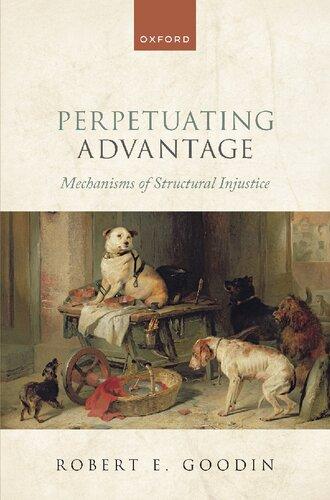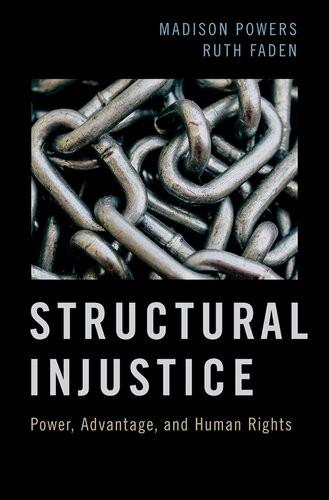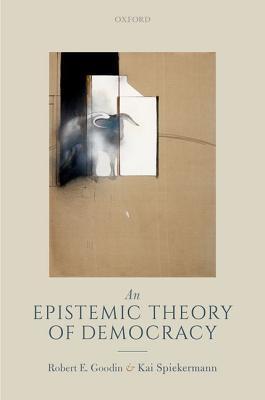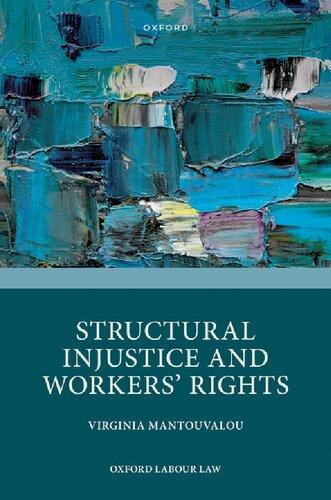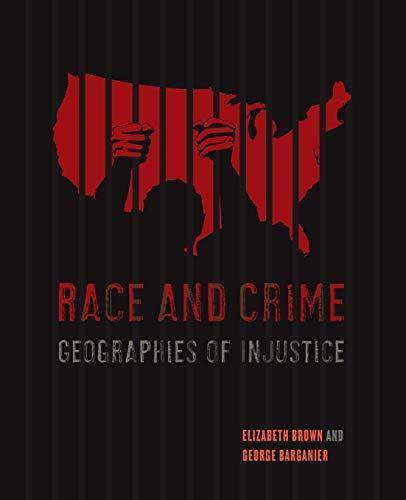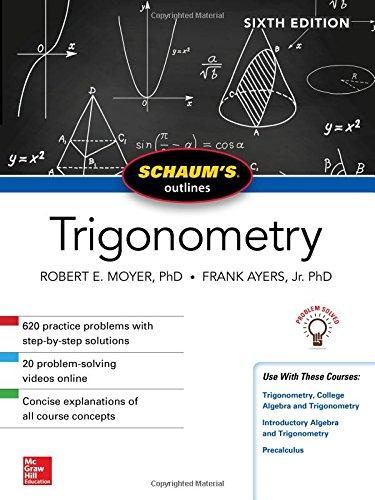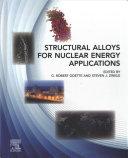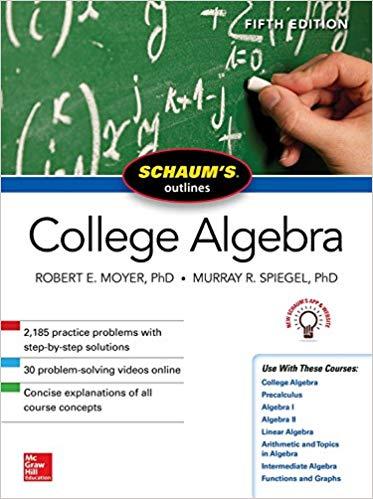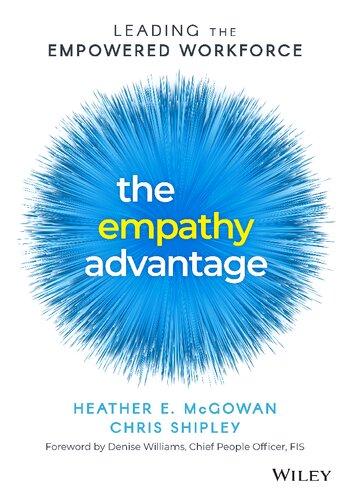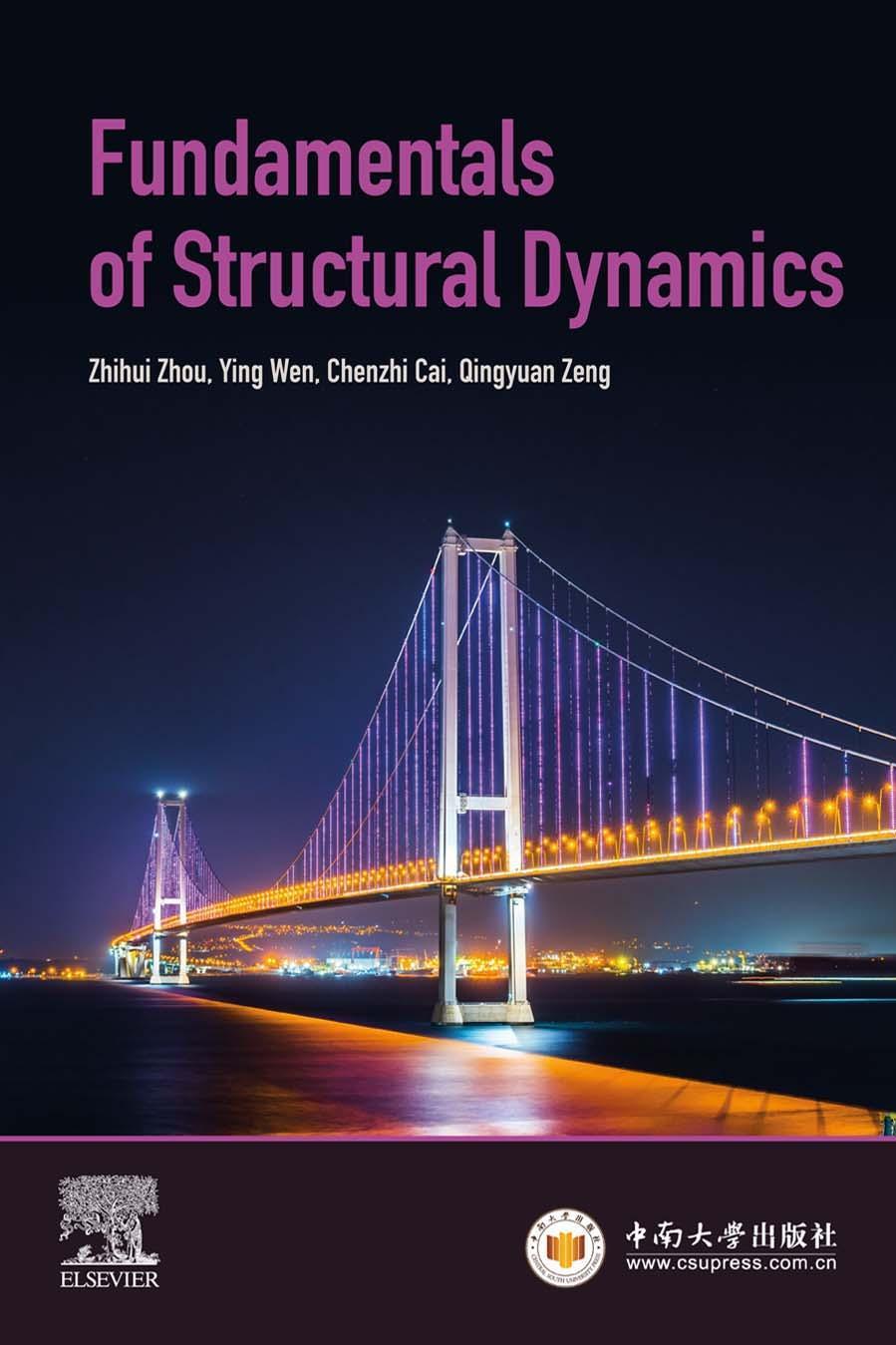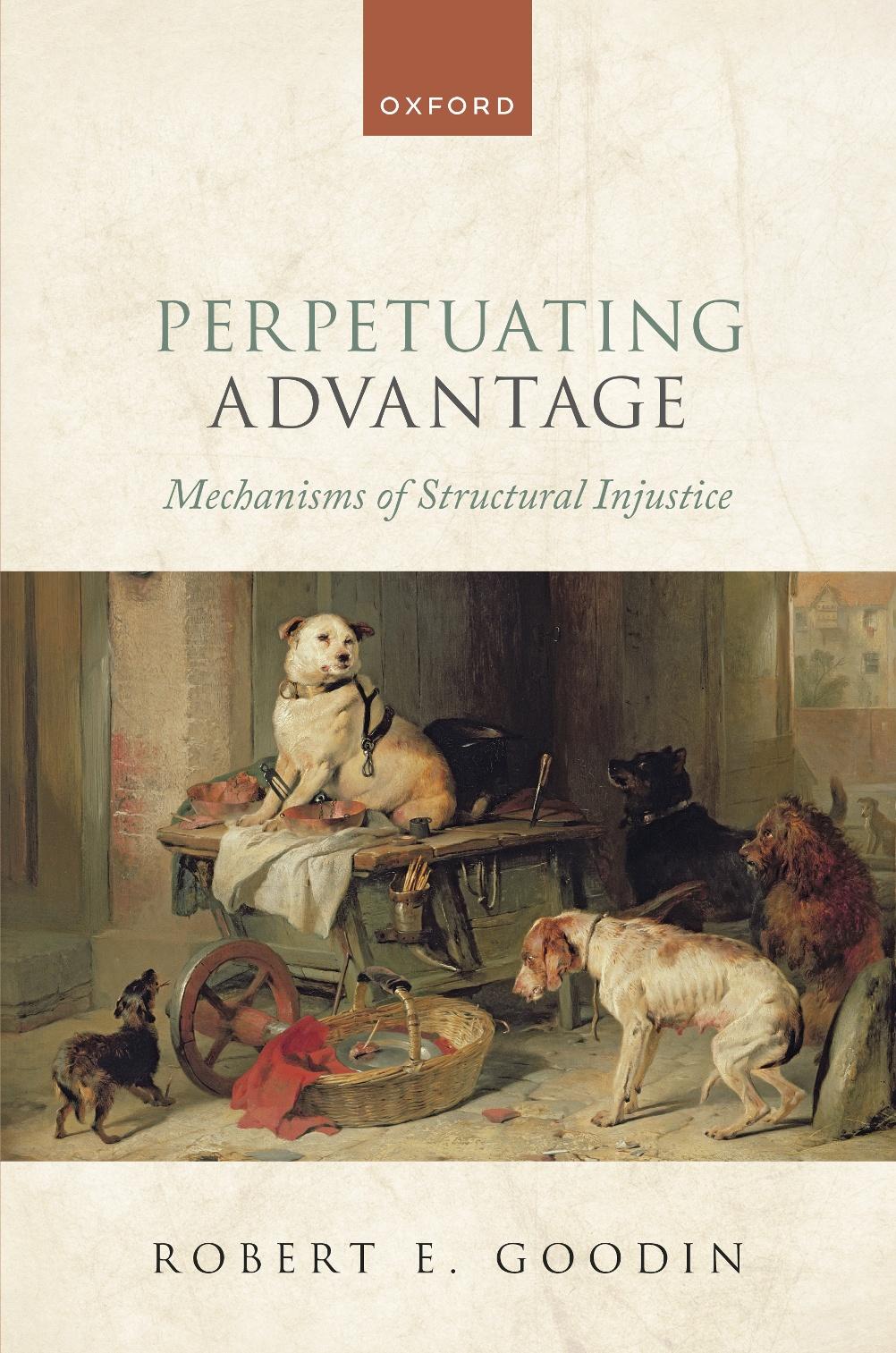PerpetuatingAdvantage
MechanismsofStructuralInjustice
ROBERTE.GOODIN
GreatClarendonStreet,Oxford, OX26DP, UnitedKingdom
OxfordUniversityPressisadepartmentoftheUniversityofOxford. ItfurtherstheUniversity’sobjectiveofexcellenceinresearch,scholarship, andeducationbypublishingworldwide.Oxfordisaregisteredtrademarkof OxfordUniversityPressintheUKandincertainothercountries
©RobertE.Goodin2023
Themoralrightsoftheauthorhavebeenasserted Allrightsreserved.Nopartofthispublicationmaybereproduced,storedin aretrievalsystem,ortransmitted,inanyformorbyanymeans,withoutthe priorpermissioninwritingofOxfordUniversityPress,orasexpresslypermitted bylaw,bylicenceorundertermsagreedwiththeappropriatereprographics rightsorganization.Enquiriesconcerningreproductionoutsidethescopeofthe aboveshouldbesenttotheRightsDepartment,OxfordUniversityPress,atthe addressabove
Youmustnotcirculatethisworkinanyotherform andyoumustimposethissameconditiononanyacquirer
PublishedintheUnitedStatesofAmericabyOxfordUniversityPress 198MadisonAvenue,NewYork,NY10016,UnitedStatesofAmerica
BritishLibraryCataloguinginPublicationData Dataavailable
LibraryofCongressControlNumber:2022950607
ISBN978–0–19–288820–4
DOI:10.1093/oso/9780192888204.001.0001
Printedandboundby CPIGroup(UK)Ltd,Croydon,CR04YY
LinkstothirdpartywebsitesareprovidedbyOxfordingoodfaithand forinformationonly.Oxforddisclaimsanyresponsibilityforthematerials containedinanythirdpartywebsitereferencedinthiswork.
Thetruthis,whenitcomestoallthosetidystoriesofhardworkand self-determinationthatweliketotellourselvesaboutAmerica,well, therealityisalotmorecomplicatedthanthat.Becausefortoomany peopleinthiscountry,nomatterhowhardtheywork,therearestructuralbarriersworkingagainstthemthatjustmaketheroadlongerand rockier.Andsometimesit’salmostimpossibletomoveupwardatall.
—MichelleObama,2020
6.2.1MoralNorms
6.2.2SocialNorms
6.2.3RoleNorms
6.4.1SuccessfullyExercisingTemporallyExtendedAgency
7.4ReputationforReliabilityandTrustworthiness
7.4.1WhyTrustMatters
7.4.2AssortationbyReputation:Trust-basedNetwork
8.CoordinationandOrganizationConferAdvantage
8.2.1FormalCoordinationbyMutualAgreement
8.2.2SharedNormsorConventions
8.2.3MutualAdjustment
8.2.4MutualAlignment
8.3StructuresforCoordinating:Organizations,Formal andInformal
8.4TheBiasesofOrganization
PARTII.UNDERLYINGDRIVERS
11.2Head-onAttacksonMechanismsPerpetuatingAdvantage
11.2.1DestroytheMechanisms
11.2.2ReducetheNeedfortheMechanisms
11.2.3ReducetheDifferentialAdvantagesConferred
11.3AmeliorationStrategies
11.3.1SiphonOfftheBenefits
Preface
Theimpetusbehindthisbookisaconcernwithsocialinjusticeanddespairat thewayinwhichsocialstructurescanservetobakeitintooursocialrelations. Theaimofthebookistounderstand how thathappens.Whatarethevarious mechanismsthatmightbeinplay?Howdotheywork,andhowmighttheybe interrupted?Understandingisthussought,mostfundamentally,asanaidto action.
Analysingstructuralinjusticebyfocusingonthemechanismsthatperpetrateandperpetuateitisbeneficial,twiceover.First,thatfocusenablesme tomakeauniquecontributiontothesediscussions.Forallthevoluminous literatureonstructuralinjustice,thereispreciouslittleontheprecisemechanismsbywhichitoccurs.Suchdiscussionsasdoexisttendtofocusonone particularmechanismoranother.Thereisnoremotelycomparableattempt atacomprehensive,systematicsurveyofallsuchmechanismsandhowthey fittogether.Mydiscussion,likepreviousones,willstartbyisolatingandtryingtoseparateouttheindependenteffectsofeachofthemanymechanisms ofstructuralinjustice.Butmydiscussionwillalsobesensitivetothelarger ecologywithinwhicheachmechanismworks,alongsidewithandoftenreinforcedbyothersuchmechanismsandoftenbeingheld(oftenveryimperfectly) incheckbysomecountervailingmeasures.WhenIsaythatsomemechanism hastheeffectofcausing'therichtogetricher',metaphoricallyoralltoooften literally,thatwillthereforealwaysbeasapartialratherthanglobalclaimpertainingpurelytotheeffectofthatparticularmechanism'initself'ratherthan theoveralltendencyofthelargersystemwithinwhichitoperates,necessarily.
Asecondbenefitoffocusingonmechanismsisstrategic.Thatfocusenables metoskirttwovexedproblems:first,howtodefinestructuralinjustice;and second,how,atahighlevelofabstraction,tocharacterizeresponsibilities forremedyingit.Proposalsonbothscoresproliferate,withnoresolution inprospect.Focusingonmechanismsofstructuralinjusticeallowsmeto sidestepthosetwinquagmires.Hereisthereason.Whateverelseitis,structuralinjusticeis'unfairadvantageanddisadvantageperpetuatedthrough socialstructures'.Andthemechanismsperpetuatingadvantageanddisadvantagethroughsocialstructuresaremuchthesame,whetherthepatternof
advantagesanddisadvantagesproducedissubstantivelyfairorunfair.Hence wedonotneedtoanswertheconceptualquestionof'whatisstructuralinjustice?'inordertoanswerthemechanismquestionof'howisitperpetuated?' Furthermore,oncewehaveansweredthemechanismquestion,wewillhave amorepreciseideaofwhatneedstobedonebywhominorderforittobe overcome.Highlevel,abstractdebatesoverhighlystylizedmodelsofdifferent typesofresponsibilityforovercomingstructuralinjusticeingeneralcanthen bereplacedwithmuchmorefine-grainedandtailor-madeprescriptions.
Thisbookisfundamentallyaconceptualmappingexercise.Theaimisto provideaninventoryofthemanyandvariedmechanismsbywhichsocial structuralmechanismscanperpetuateadvantageanddisadvantage.Idraw examplesfrommanydifferentplacesandmanydifferentperiods.Iofferthose empiricalexamplespurelyas'proofsofconcept'.Theyservesimplytoshow thatsomesuchmechanismsarenomereflightsofphilosophicalfancy—those mechanismshaveactuallyfiguredsomewhereintherealworld,atsomepoint oranother.
Beforemountingthelargerpoliticalprojectofattackinganyparticular instanceofstructuralinjustice,ofcourse,furtherempiricalwillberequired toascertainwhichmechanismsare presently atworkinthat particular setting.Thatisataskforelsewhereandlater,notthisbook.Still,byshowing whatallmechanismstolookoutfor,Ihopethatthisconceptualmapping exercisemightserveasusefulgroundworkforthatlargersocialscientific,and ultimatelypolitical,project.
Ishouldadd,finally,thatmyaimhereistoprovideamappingofgeneric typesofmechanismsthatperpetuatesocialadvantage.Notonlymaydifferent onesofthosemechanismsbeatworkatdifferenttimesandplaces,asIhavejust said.Eachspecificmechanismmayalsoworkdifferentlynotonlyatdifferent timesandplacesbutalsoasappliedtodifferentsourcesofsocialadvantage (genderversusrace,forexample).Those,too,arequestionsrequiringfurther empiricalinvestigationbeforemountingapracticalattackonanyparticular instanceofstructuralinjustice.Identifyinggenericmechanisms,asisdonein thisbook,isonlyafirststep—buthopefullyausefulfirststep—inthatlarger empirical,andultimatelypolitical,process.
Althoughthecurrenttextisofrecentvintage,thisbook'sdeeperoriginsand manyofitsideasaretheproductsofagreatmanyconversationsoveragreat manyyears.IdiscussedagencyandstructureatlengthwithBobJessopand HughWardinthe1980sandstructuralinjusticeatlengthwithIrisYounga
xiii coupleofdecadeslater.BrianBarryandIdiscussedpositionalgoodswith FredHirschinthe1970s.IdiscussedmechanismsmoregenerallywithJon Elster,ArtStinchcombe,andChuckTillyoverthenextthreedecades.AndI discussedallthosetopicsandmanymorewithClausOffe,duringhis15years ofrecurringvisitstoANUasourAdjunctProfessor.Inmanywayslargeand small,thisbookreflectsthecaldronofinterdisciplinaritythatwastheANU ResearchSchoolofSocialSciencesinitsheyday.
WhileIhavethusbeenunwittinglyassemblingresourcesforthisbookfor quitesometime,theygelledintoaunifiedwholeonlyrelativelyrecently.One impetuswascollaborationwithChristianBarryonvariousrelatedprojects overthepastdecade.AnotherimpetuswasconversationswithAnaTanasoca concerningmechanismsunderlyingpublicdeliberationinnaturalizedsettings.Intheearlystagesofitscomposition,thebookbenefitedfromconversationalinputfromAmandineCatala,TimoJu¨tten,AveryKolers,andJosh Ober.Atlaterstagesvaluablecommentsonthemanuscriptasawholecame fromBruceHeadey,AveryKolers(onceagain),KaiSpiekermann,KatieSteele, andrefereesforOxfordUniversityPress.Iamonceagaingratefultomylongstandingeditorthere,DominicByatt,forskilfullyshepherdingtheprojectto successfulcompletion.
Thisbookwasdraftedinthesemi-solitudeofcoronaviruslockdowns.Isaac Newtonmademuchbetteruseofasimilarperiod,threeandahalfcenturies before.Still,likehim,Ifoundtheperiodhighlyfruitful.
Introduction
Thisbookisdeeplyconcernedwithinjustice.Butunlikemostbooksonthe subject,itisrelativelyunconcernedtospecifywhatinjusticeisorhowitcomes aboutinthefirstinstance.Thisbookisfocused,instead,onhowinjusticeis perpetuatedovertime.¹
Experiencinganinjusticeisbad,eveniftheinjusticeisquicklycorrected. Butitisworsetoendurethatinjusticeforaprotractedperiod.² Itiswrongto commitaninjustice,evenknowingitwillbequicklycorrected.Butitisworse tocommitthatinjusticeifitislikelytobelonglasting.Itisbadtoperpetuate anunjuststateofaffairsthatwouldotherwisefadeaway—sometimesasbad ascreatingitinthefirstplace.³
Sometimesadvantagesanddisadvantagesareperpetuatedthroughthesame mechanismsbywhichtheyarecreatedinthefirstplace.Taketheexampleof aracistestateagentwhorefusestoshowanyhouseinawhiteneighbourhood toanyblackbuyer.Thesameracismleadstheestateagenttodiscriminate againstablackhomebuyerfirstforoneproperty,andthenforanother,and themforanother.⁴ Thesamethingthatdisadvantagesblackhomebuyersin thefirstinstancekeepsdisadvantagingthemoverandoveragain.
Othertimes,unjustadvantagesanddisadvantagesareperpetuatedthrough mechanismsdifferentthanthosecreatingtheminthefirstplace.Hereisacommonscenarioofthatsort:theinitialinjusticewasperpetuatedthroughabrute actofinterpersonalpower;thatinjusticeisthenperpetuated,notthrough
¹ As Haslanger(2012,p.332)says,ifonlyinpassing:‘Inconsideringoppressionitisimportantto askthreeseparatequestions:(1)Doestheinstitution cause or create unjustdisadvantagetoagroup? (2)Doestheinstitution perpetuate unjustdisadvantagetoagroup?(3)Doestheinstitution amplify or exacerbate unjustdisadvantagetoagroup?Thereisatendencytofocuson(1)whenaskingwhether aninstitutionisoppressive.But(2)and(3)arenolessimportanttopromotejustice.’Forananalysis ofHaslanger’sthirdcategory,see Hellman’s(2018) discussionof‘compoundinginjustice’.
² Onthenotionof‘enduringinjustice’see Spinner-Halev(2012,esp.ch. 3).
³ If,forexample,doneintentionallyandwithlong-lastingeffects.See BarryandWiens(2016) and Section 1.2 below.
⁴ Youcancallit(i)acaseofpersistinginjustice(theblackhomebuyercontinuesbeingrefusedproperties)or(ii)acaseofrepeatedorreplicatedinjustice(eachrefusalisunjust,justlikethelast)or(iii) acaseofexpandinginjustice(withthediscriminated-againstblackhomebuyerbeingdeprivedofan increasingproportionofhousesinthewhiteneighbourhood).Thosedescriptions,andtheunderlying phenomena,aredifferentinimportantrespects,aswillbeelaborateduponinChapter 2.Forpurposes ofthepointbeingmadehere,however,theydonotmatter.
PerpetuatingAdvantage.RobertE.Goodin,OxfordUniversityPress.©RobertE.Goodin(2023). DOI:10.1093/oso/9780192888204.003.0001
recurringexercisesofinterpersonalpowerofthesamesort,butratherby itshavingbeenembeddedinimpersonalstructuresthatthensurreptitiously shapesubsequentexercisesofagency.⁵ Thehistoryofemancipatedslavesin theAmericanSouthaftertheCivilWarisaprimeexample.Emancipation broughtformerslavesacertain(ifimperfect)measureoffreedomfromthe bruteoppressionofwhitemastersandoverseers.Thetermsoftheiremancipation,however,madeitstructurallyinevitablethattheywouldbecomelandless share-croppersin‘debtpeonage’tocreditmerchants.⁶
Suchstructuresservetochannelsubsequentexercisesofagency,constrainingitincertainrespectsatthesametimeasenablingitinothers.Structures makesomecoursesofactioneasierormorerewarding,whilemakingother coursesofactionmoredifficultorcostly—anddifferentiallyso,fordifferent groupsofactors.
Thatissimplywhatstructuresdo.WhenHabermaswritesabout TheStructuralTransformationofthePublicSphere,forexample,hisreferenceisto twodevelopments—theeighteenth-centuryriseofthecoffeehouseandof thebroadsheetnewspaper—thattogetherfacilitatedpoliticalcommunication amongthebourgeoisieandthegrowthofacivilsocietyindependentfrom courtlypolitics.⁷ Whentrust-bustersattheendofthenineteenthcentury condemnedinterlockingdirectorates,theywerecomplainingaboutcorporate governancestructuresthatfacilitatedcoordinationamongnotionallyindependentcorporationsthatweresupposedtobecompetingwithoneanother, thusenablingthemtocolludeonartificiallyhighpricesandotherarrangementsinrestraintoftrade.⁸ Thelattersortsofstructuresaretobebemoaned, theformertobewelcomed.Butbotharestructuresofasimilarsort,createdby
⁵ Thereisanaturalimpetustotryto‘hide’therecurringeffectsofinjusticesbehindimpersonal structures,ratherthanre-enactblatantlywrongfulactstimeandagain(Nuti2019).Inanoppressive structure,as Young(1990,p.41)says,‘causesareembeddedinunquestionednorms,habitsandsymbols,intheassumptionsunderlyinginstitutionalrulesandthecollectiveconsequencesoffollowing thoserules….Inthisextendedstructuralsenseoppressionreferstothevastanddeepinjusticessome groupssufferasaconsequenceofoftenunconsciousassumptionsandreactionsofwell-meaningpeopleinordinaryinteractions,mediaandculturalstereotypes,andstructuralfeaturesofbureaucratic hierarchiesandmarketmechanisms—inshort,thenormalprocessesofeverydaylife.’
⁶ Foramorerecenteconomichistory,see RansomandSutch(1977).Foranolderandmoreevocativesocialhistory,seeDuBois’sclassicaccountof BlackReconstruction whichconcludes:‘Itwasthe policyofthestatetokeeptheNegrolaborerpoor,toconfinehimasfaraspossibletomenialoccupations,tomakehimasurpluslaborreservoirandtoforcehimintopeonageandunpaidtoil’(1935, p.696,seefurtherch. 14).
⁷ Habermas1962/1989
⁸ Brandeis1914; BaranandSweezy1966.Havingoneof‘J.P.Morgan’smen’onitsboardhasbeen calculatedtohaveincreasedthevalueofafirm’scommonstockequitybysome30percentintheyears beforeWorldWarI,inpartbecauseit‘aidedtheformationofoligopoly’(DeLong1991).Onsubsequentperiods,seeUseem(1983), Knoke(1993) andforthelatestmanifestation(‘hybridnetworks’) Teubner(2002)
humanagencyandemployedbyhumanagentsinpursuitoftheirpurposes, aidingsomeandinhibitingothers.⁹
Thestructuresofinterestinthisbookareallsocialconstructslikethat.Some taketheformofphysicalinfrastructure,likebridgesandborderwalls.¹⁰Others aresocialinfrastructure—socialinstitutions,practices,relations,andthelike.¹¹ Somepartsofthatsocialinfrastructureconstituteintentionalagentscapable ofactingintheirownright.Corporations,clubs,andnationalgovernments areexamplesofthat.Butevenstructuresthatarethemselvesintentionally inert(likebridges,constitutions,andcodesofetiquette)nonethelessserveto channeltheintentionalactionsofothers.¹²
Sometimes,asinthecaseofthecoffeehouses,theseeffectsmaybeunintended.Othertimes,asinthecaseofinterlockingdirectorates,theyarefar fromthat.Thelattersortsofstructuresembodytheossifiedintentionsofthose whocreatedandrecreatedthem,workingwith,on,andthroughthosestructures.Thosesortsofstructuresareofparticularmoralconcernforthatreason. Buttheformersortsofstructuresareofconcernaswell.Thosestructureshave theeffect,unintendedbutnonethelessveryreal,oftiltingthesocialplaying fieldsystematicallytotheadvantageofsomeandthedisadvantageofothers. Thatisworryinginandofitself.
Allthatisfamiliarfromtheexistingliteratureonstructuralpowerandstructuralinjustice.¹³Whatissubstantiallymissingfromthatliteratureisanyproper accountofwhatexactlythestructuresinquestionare,andhowexactlythey worktoperpetuateinjustice.¹⁴ Likewise,gesturingtowards‘pathdependency’ issimplytoasserttheconclusionthatpastchoicesaffectfutureones,rather thantoofferanexplanationofhow,exactly,thathappens.¹⁵
⁹ Hayward(in HaywardandLukes2008,p.16)equates‘structuralconstraints’with‘codifiedand institutionalizedhumanactionsthatcreatepatternedasymmetriesinthesocialcapacitytoact’.See similarly: MacIntyre1999; Reiman2012.
¹⁰ LiaoandHuebner2021
¹¹ Haslanger2016.
¹² Reiman1989,p.203. Young2011,pp.53–6.Thelimitingcasemayberobots,whichmayormay notbeintentionallyinert:buttheycertainlyhavebeenintentionallyprogrammedbyhumanagents; thoseprogrammers’valuesinfusethoserobots’designandtheirdesignshapestheusestowhichthey canbeput(Sparrow2021).
¹³ Seminaltextsinclude: Galtung1969, 1990; Young2011,ch. 2; Haslanger2012,ch. 11;2016,2017. ForabriefoverviewofdebatesgrowingoutofYoungandHaslanger’sworkseeMcKeown(2017).
¹⁴ Critiquing Sewell’s(1992) conceptof‘structure’, Lizardo(2010,p.675)worries‘whethersucha widerangingnotioncanbeusefulforactualresearch….[I]fstructuresrefertoeverything,theyalso refertonothingatall’.Henceweshouldmovefromthestudyof‘structuralism’tothestudyofspecificstructures—justasIargueweshouldgetpastgeneralitiesabout‘structuralinjustice’andexamine specificmechanismsperpetratingit.
¹⁵ Generically,pathdependencyjustsaysthatpastoutcomesshapefutureoutcomesbymakingsome optionseithermorerewardingorlesscostly.Buthowexactlytheydothatisanopenquestionnot answeredbythesheerfactofpathdependency.Itcouldbebymakingsomeoptionsconceptually
Thestandardlaundrylistofsourcesofstructuralinjusticeidentifies where structuralpowerresides.Wearetoldthatitisfoundinthepoliticalsystem, intheeconomy,insociety,inculture,inlanguage,inthephysicalenvironment,bothbuiltandnatural.Allthat,however,ismerelytonamethe sites wherestructuralinjusticeoccurs.Whatwereallyneedtoknowisnotsomuch wherestructuralinjusticeoccursbut,instead, bywhatmechanisms itoccurs, how thosemechanismswork,andhowtheycanbe stopped fromworking.¹⁶ Exploringthatlattersetofissuesisthelargeraimofthisbook.
Focusingonmechanismsthatperpetuatestructuralinjusticeservesavery particularpurpose.The‘mechanismapproach’aimsat‘openingupblack boxes,…strivingfornarrowingthegap…betweeninputandoutput,cause andeffect.Amechanism-basedexplanationseekstoprovideafine-grainedas wellastightcouplingbetweenexplanansandexplanandum’.¹⁷ Thatisthefirst aimofthisbook—tounderstandthemechanismsbywhichadvantage(most especially,unjustadvantage)isperpetuated.
Thatfirstaimisinserviceofasecond,whichistounderstandthemechanismsperpetuatingunjustadvantageinhopesofdisruptingthem.Sometimes bycallingaproblem‘structural’wemeanmerelytosaythatitisnotamenable toanypolicysolutions,anywaynotatanacceptablesocialcost.‘Structural unemployment’isaclassicexampleofthatusage.¹⁸ Clearly,Irejectthatusage. Forme,aproblemis‘structural’ifitissourcedinstructures—morespecifically, oneofthemechanismsIshalldiscussinPartIIofthebook.
Aproblemisallthemoreproblematicifitdefiesanycost-effectivepolicy remedies,tobesure.Butthatisnotthedefiningfeatureofa‘structural’problem.Manyproblemsthataregenuinelystructuralinmysensemaywelldefy cost-effectivepolicyremedies.Butthatisnottrueofallcasesofunjustperpetuationofadvantagethatareproperlyseenashavingstructuralsources.Many canatleastbeameliorated,ifnotremediedaltogether,inwaysthatIelaborate inChapter 11. morefamiliar,moreaccessibleviaexistingnetworksororganizationalstructuresorbettersupported byexistingsocialnormsandexpectationsandreputationalstructures.Onpathdependencyingeneral see: David1985; Arthur1989; Pierson2000.Onthemanydifferentwaysofformallymodellingpath dependency,otherthanthe‘outcome-dependent’versionjustsketched,see Page(2006).
¹⁶ AsReskin(2003,p.16)remarkedinherPresidentialAddresstotheAmericanSociologicalAssociation,‘Inexplainingsocialstratification,identifyingmechanismsisparticularlyimportantbecause—as themethodsfordistributingsocialgoods—theyaretheenginesofequalityandinequality.’
¹⁷ Hedstro¨mandSwedberg1998,p.25.Seefurthertheotherchaptersinthatcollection,aswellas: Elster1983, 1989, 2007; Stinchcombe1991; Tilly2001; TillyandGoodin2006,pp.14–9; Hedstro¨m andBearman2009; Hedstro¨mandYlikoski.2010.
¹⁸ InaUSDepartmentofCommercepublication,forexample, BergmannandKaun(1967,ch. 1) define‘structuralunemployment’as‘thatamountofunemployment(lessminimalfrictionalandseasonal)whichcannotberemovedbymonetaryandfiscalpolicywithoutcreatingcontinuinginflation (asopposedtoone-shot,nonrepeatablepricerises)derivingdirectlyfromshortagesoflabor’.
Indiscussingstructuralmechanismsthatperpetuateadvantage,Ishallbe discussingthemintheirmostgenericforms.Theirparticularinstantiationsof coursevarywildly,andinterventionsaimingtointerrupttheirworkingsmust ofcoursebesensitivetothoselocalvariations.Butitisequallyimportant,if notmoreso,tobeattunedtotheirgenericworkings.Takeforexamplenetworks,thetopicofChapter 4.Thosenetworksmighttakemanyforms:trade routes,railroadtracks,telegraphlines,orkinshiporfriendshipbonds.But whateverthespecificform,networksareallalikeindistributinginformation andothervaluedresourcestothosewithinthenetworkandmostparticularly tothoselocatedcentrallywithinit,totheadvantageofthosewithinandthe disadvantageofthoseoutsideofthosenetworks.
Finally,thestructuresIshallbediscussinghavebothexternalandinternal aspects.Inthenetworkexamplejustdiscussed,therailandtelegraphlinesare anexampleoftheformer,thefriendshiptiesanexampleofthelatter.Some internalaspectsarephysical(sex,disability,toshiftexamples).¹⁹Otherinternal aspectsaremorepsychological.ExamplesofthatincludeChapter5’sconcepts, codes,andcategories——whatmanywouldcall‘ideologies’—throughwhich weinterpretourworld.Otherexamplesaretheexpectationsandreputations thatshapethewayweinteractintheworld,discussedinChapters6and7.The senseofentitlementandtheself-confidencethatthoseconferonthealready advantaged,andthedemoralizationthattheyinstilinthedisadvantaged,contributesubstantiallytotheperpetuationofexistingpatternsofadvantageand disadvantage.²⁰
1.1 Structures and Agents
Theveryterm‘structuralinjustice’woulditselfbeanoxymoronif‘structure oragent’were—asithassometimesbeentreatedasbeing—agenuinelymutuallyexclusivedichotomy.²¹ Thereasonissimplythatstructuresthemselves
¹⁹ Atleastinsofarasyouaccept—asIdo—thatthosearenot purely socialconstructs.
²⁰ Thegeneralobservationisitselfsomethingofacommonplace,famouslyexpressedbyMahatma Gandhi:‘Manoftenbecomeswhathebelieveshimselftobe.IfIkeeponsayingtomyselfthatIcannot doacertainthing,itispossiblethatImayendbyreallybecomingincapableofdoingit.Onthecontrary, ifIhavethebeliefthatIcandoit,IshallsurelyacquirethecapacitytodoitevenifImaynothaveitat thebeginning’(quotedin Deats2005,p.108).Formorepopulartreatmentssee: Peale1952; Beauvoir 1955; Bell1976,p.233; Manne2020.Formoreacademic(social-scientificorphilosophical)onessee: Cook1975; Derber1978; Major1987; BénabouandTirole2002; FlåmandRisa2003;Morton2021; Gomez2022
²¹ Althoughenthusiastssometimesphraseitinthishyperbolicway,morejudiciousscholarsmerely claimthatstructurescansometimescauseoutcomeswithouttheinterventionofanyhumanagency. Galtung(1969,p.170)forexamplewrites:‘Weshallrefertothetypeofviolencewherethereisan actorthatcommitstheviolenceas personal or direct,andtoviolencewherethereisnosuchactoras structural orindirect.’(Heequates‘structuralinjustice’withthelatter:p.171.)Galtunggoesontoargue
lackagency.²² Yetinjusticeisawrong,andawrongbydefinitionrequiresthe exerciseofagency.²³
TheOxfordEnglishDictionary definesa‘wrong’asan‘unjustactionorconduct’byonepersonthatcauses‘injury,hurt,harm,orprejudice’toanother.²⁴ Actionsarenotsimplyhappenings—eventsthatoccurintheworld.Theyare thedoingsofactorsintentionallyexercisingtheiragency.²⁵ Thoseagentsmay benaturalindividuals,ortheymaybeartificiallycreatedentities(likecorporations)orformallyorganizedgroupsofnaturalindividuals(likegangs).But evenartificialorcollectiveagentsact,whentheydo,viatheexerciseofagency bynaturalindividualswithinthem.
Talkof‘structuralinjustice’purportstodrawattentiontowaysinwhich unjustadvantageisperpetuatedbystructures ratherthan agents.²⁶ Theaimis toencourageustostoplookingfor‘badpeople’toblame,andtolookinstead atsocialstructuresthatlead‘goodpeople’todobadandenable‘badpeople’ todobad.²⁷
Ifthe‘ratherthan’intheclaiminthepreviousparagraphweretaken literally,however,theclaimwouldbenonsensical.Thingspossessingno agencycancommitnoacts;hence,neithercantheycommitanywrongs
thatthetwoare‘empiricallyindependent’ofoneanother—‘itispossibletohavetheminpureforms, tohaveonewithouttheother’(p.178).Seemoregenerally, Dawe(1970) on‘thetwosociologies’.
²² Sociologistssometimestalkasifstructurepossessesagency,aswhen Sewell(1992,p.2)writes: ‘Structure,initsnominativesense,alwaysimpliesstructureinitstransitiveverbalsense.Whatever aspectofsociallifewedesignateasstructureispositedas“structuring”someotheraspectofsocial existence….’ButthatisjustaclassicexampleofwhatRyle(1931–1932)callsa‘systematicallymisleading expression’.
²³ Oneofthegreatthemesofthestructuralinjusticeliterature,ofcourse,isthatthemacro-social consequencesofexercisesofindividualagencycanbewrongwithouteachorindeedanyofthose individualexerciseshavingbeenculpableorwrong.In Haslanger’s(2012,p.318)example:‘thedistributionofpowermaybeunjustandyettheinjusticenotbeproperlyexplicatedintermsofanagent’s wrongdoing’.Yetthoseindividualactsmighthavebeenwrong,takingasuitablybroaderviewofthe variouswaysinwhichindividualsmightbeculpable(e.g.,foromissionsaswellasacts,fornegligence aswellasintentionalharms,forlegacyaswellascontemporaneouswrongs)(Estlund2020).As Young (2011,p.96)says,evenif‘[t]heactionsofparticularpersonsdonotcontributeto[structural]injustice forotherpersonsdirectly’,theydoso‘indirectly,collectivelyandcumulativelythroughtheproduction ofstructuralconstraintsontheactionsofmanyandprivilegedopportunitiesforsome’.Iwouldargue that,insofarastheycanandshouldforeseethosecumulativeconsequencesoftheiractionstogether withthoseofothers,wecanandshouldholdthosepeopleresponsibleforthoseactions. Young(2011) clearlydoesnotwanttodwellonthat,butIamnotsureshewouldwanttodenyitatallstronglyeither.
²⁴ Qv.‘wrong(n)’,2a,5b.
²⁵ Davidson1980.Seealsothe OxfordEnglishDictionary definitionsof‘act(v)’,2aand‘action(n)’, 2,12,15b.Tosaythat‘theyintendtoact’isnot,ofcourse,tosaythattheynecessarily‘intendthe consequencesoftheiractions’.
²⁶ Wendt(1987,pp.336–7)criticizesstructuraltheoriesofinternationalrelationsformakingthis claim,whichheshowstobeexaggerated.
²⁷ Hayward,recallingActon’sphrase(in HaywardandLukes2008,pp.10–11).Seesimilarly Haslanger2015.
ordoanyinjustice.²⁸ Harmsinflictedbynon-agenticforces(likefloodsor fires)aremerelymisfortunes—maybeundeservedmisfortunes,maybegrave misfortunes,butonlymisfortunesratherthanwrongsorinjustices,strictly speaking.
Nodoubttherearesomeimportantfeaturesofthenaturalworldthattruly arebeyondthecontrolofanyhumanagent.Butagreatmanyofthemcan beaffectedatleasttosomeextentbyhumanagency.Someoneclearinghis landupstreamfromyouincreasedtheriskofyourfarmbeingflooded;someonefailingtorepairtheleveedidlikewise.Thefirethreateningyourhome mayhavebeenstartedbysomeone,accidentallyorotherwise;andsomeone failingtoback-burnattherighttimemayhavebeeninstrumentalinthefire’s reachingyourdoor.Atafewstepsfurtherremoved,thedistributionofincome andwealthinyoursocietyledtopoorerpeoplelikeyoubeingdriventolive andworkinenvironmentsatriskfromfloodingduringhurricanes,whereland andhousingischeaperinconsequence.²⁹ Or,workingtheotherwayaround, institutionalstructuresandsocialpracticesthatsuitthoseinthemetropolitancentremightnot(forreasonsofsheerdistanceorgeographicalorcultural distinctiveness)suitthoseatthefurtherperipheries.³⁰
Theupshotisjustthis.Thevastmajority(maybeliterallyall)oftheseeminglyagency-freestructuresthatperpetuateadvantageanddisadvantageactuallyhavesomesortofhumanagencystandingsomewhereinthebackground.³¹ ‘Structureoragent’isafalsedichotomy,assuchdichotomiessooftenare.³² Insteadofthinkingofoutcomesasbeingproducedby‘structures ratherthan agency’,weshouldbeattunedtowaysinwhichoutcomesmighthavebeen
²⁸ Whenwespeakofa‘cosmicinjustice’wedosoeitherinapurelymetaphoricalwayorasan allusiontosomesortofsupernaturalagency.(Defining‘cosmicirony’,the OxfordEnglishDictionary referssimilarlyto‘events…seeminglyorchestratedbyfateorprovidence’.)
²⁹ Young2006.
³⁰ Suchargumentsobviouslyhaveapplicationbothwithincountries(LipsetandRokkan1967; RokkanandUrwin1982)andglobally(Frank1966).
³¹ Galtung(1969,p.178)canvasses(butdiscountsinawayIwouldnot)thepossibilitythat‘all casesofstructuralviolencecan,bycloserscrutiny,betracedbacktopersonalviolenceintheir prehistory’andpurecasesofstructuralinjustice‘areonlypureaslongasthepre-historyofthecase…[is] convenientlyforgotten’. Wendt(1999,pp.165–84)thinks‘constitutive’structuresexertcausalpower without(further)interventionofhumanagency;but,still,humanagencywastypicallyinvolvedin puttingthoseconstitutivestructuresinplace.In Burt’s(1992) terms,thereare‘structuralholes’that (verymetaphorically)‘callforth’otherstructurestofillthem:butitishumanagentswhohavecreated thestructuresthatlefttheholes;anditishumanagentswhoanswertocalltocreatestructurestofill them.Theymaydosoindividuallyratherthancollectively,andinuncoordinatedwaysthatnonetheless havecumulativeconsequences. Vrousalis(2021,p.40)arguesforexamplethattheregulativefunction upholdingcapitalistinstitutionscanbeperformedthroughtheexerciseof‘collectivepower’evenif thereis‘nojointagencyorsharedintentionsonthepartofthedominators’.
³² Archer1982 Giddens1984.Onthemoregeneralpoint,see Goodin(2009,pp.9–12).
producedbytheinteractionofagencyandstructure.³³ Mostparticularly,we oughttobealerttopossibilitiesof‘agency workingthrough structures’.³⁴ That, Isubmit,iswhatweshouldbetalkingabout,whentalkingof‘structural injustice’—evenifthehyperbolicimageofstructuresactingontheirownis (sadlyforsome)lostintheprocess.
Noticethatthereisaconsiderablestrategicadvantageforagentstoperpetuateadvantagethroughopaquestructuresratherthanthroughdirect,blatant, transparentinterventionsoftheirown.³⁵ Workingthroughstructuresleaves nobodytoblameand‘nobodytoshoot’.³⁶ Exercisingagencythroughimpersonal,automaticmechanismsthatseemtoinvolvenoobviousexerciseof agency masks thatveryexerciseofagency.³⁷ Itisadeceptiveexerciseofpower, anditisdoublyobjectionableforthatreason.Itisworseforbeingdeceptive(whichisarguablyawronginitself);and,beingdeceptive,theexercise ofpowerisharderforotherstodetectanddeflect(soworseforthatreason,in addition).³⁸
Oftenstructuralimpedimentstotheexerciseofyourwillhavebeenplaced therebytheprioreffortsofotherhumanagents,oftenwiththeexpressintentionofconstrainingsubsequentactorslikeyouintheexerciseoftheirwillin preciselythoseways.³⁹ Thoseareinstancesinwhichpeoplehavedeliberately
³³ Young2011,pp.18,100.Seesimilarly Burt’s(1982) accountof‘structuralaction’and Giddens’ (1984) of‘structuration’asgeneralizedby Grewal(2008,pp.52–6). Wiedenbru¨g(2021) providesa workedexamplewithreferencetofinancialcrises.
³⁴ Goodin2000a.Thatshouldbeseentoinclude,particularlyinthecasesofthecognitivestructures discussedinChapters 5 and 6,‘agencynotseeinghowitcanworkgiventhestructures’.Seemore generally: Wendt1987; IngramandClay2000.Thatpointalsoappliesinrelationto‘structuralpower’ (HaywardandLukes2008),‘socialcapital’(Coleman1988,p.S98;1990,p.302)andthe‘actsofartifacts’ (cf. Latour1999,pp.176–7; Verbeek2005,p.154andch. 5 passim; IlliesandMeijers2009; Peterson andSpahn2011).
³⁵ In Bourdieu’s(1986,pp.254–5)example,‘Whenthesubversivecritiquewhichaimstoweaken thedominantclass…isincorporatedininstitutionalizedmechanisms(forexample,lawsofinheritance)aimedatcontrollingtheofficial,directtransmissionofpowerandprivileges,theholdersof capitalhaveanevergreaterinterestinresortingtoreproductionstrategiescapableofensuringbetterdisguisedtransmission…byexploitingtheconvertibilityofthetypesofcapital.Thusthemorethe officialtransmissionofcapitalispreventedorhindered,themoretheeffectsoftheclandestinecirculationofcapitalintheformofculturalcapitalbecomedeterminantinthereproductionofthesocial structure.Asaninstrumentofreproductioncapableofdisguisingitsownfunction,thescopeofthe educationalsystemtendstoincrease….’
³⁶ HaywardandLukes2008 JugovandYpi(2018) pointsimilarlytothe‘epistemicopacity’ofstructuralinjustice.Thisisthesourceofthecommonobjectionthat,ifnoone(inparticular)istoblamefor structuralinjustice,thenmorallyeveryonegetsa‘freepass’(Nussbaum2011,p.xxi)inrelationtoit. SeeBarryandMacdonald2016;Neuha¨user2014;Zheng2018a;and,foranoverview,McKeown2017
³⁷ As Galtung(1969,p.173)says,‘Structuralviolenceissilent,itdoesnotshow….’ Young(2012, pp.54–5)expandsuponthisthought.SchilkeandRossman(2018,p.1082)offerexperimentalevidence of‘structuralobfuscation’.
³⁸ Goodin1980,esp.ch. 1
³⁹ Butnotalways—andasIhavesaidstructuresthatlockininjusticewithoutanyoneintendingfor themtodosoarenotnecessarilyanythelessmorallyobjectionableforthatfact.
createdorotherwiseavailedthemselvesofstructuresthat‘lockin’injustice,in awaythatrequiresnofurtherdirectexerciseofagency.⁴⁰
ThethoughtisasoldasRousseau’sDiscourseonInequality.Therehewrote: ‘Thefirstmanwho,havingenclosedapieceofground,bethoughthimselfof saying,“Thisismine,”andfoundpeoplesimpleenoughtobelievehim,was therealfounderofcivilsociety.’⁴¹ ItisasnewastheLongIslandExpressway, whoseoverpassesweredeliberatelybuiltsolowastoprecludeinner-cityblacks ridingbusesfromreachingtheaffluentsuburbsbeyond.⁴²
Impedimentsofallthosesortsarethesubjectofthisbook.Thestructures ofmostinterestareoneswhoseeffectsareperduringandpervasive.TheUS SupremeCourtemploysjustsuchstandardsindistinguishingerrorsthatit calls‘structural’fromothersortsoferrorinthetrialprocess.⁴³
Onefinalnoteonmethod.Inthechaptersthatfollow,Ishallprimarilyfocus onstructuresthatworkinseemingly‘innocent’ways(whichistosay,without thefurtherinterventionofanynefarioushumanagency)toperpetuatesome people’sadvantageandothers’disadvantage.⁴⁴ Iamparticularlyinterestedin suchmechanisms,preciselybecausetheyaresoeasilyoverlookedwhenfocusing,aswemoretypicallydo,onthedastardlydeedsoftherichandpowerful infeatheringtheirownnests.
Infocusingonthosemore‘innocent’sourcesofstructuralinjustice,Ido notdenythatothermorenefariousagenticforcesarealsooftenatwork,both
⁴⁰ Inaratherdifferentconnection,theUSSupremeCourthasheldthat‘practices,procedures,or testsneutralontheirface,andevenneutralintermsofintent,cannotbemaintainediftheyoperateto “freeze”thestatusquoofpriordiscriminatoryemploymentpractices’(Burger1971).
⁴¹ Rousseau1755/1973,pt.2,p.76. Hume1752/1760)sayssimilarly:‘Itisconfessed,thatprivate justice,ortheabstinencefromthepropertiesofothers,isamostcardinalvirtue:Yetreasontellsus, thatthereisnopropertyindurableobjects,suchaslandsorhouses,…butmust,insomeperiod, havebeenfoundedonfraudandinjustice.’Forcontemporaryechoessee: Pateman1988; Mills1997; PatemanandMills2007; Piketty2020
⁴² Winner1980,pp.123–4;seefurther Caro1974,pp.951–8.Otherstudiesshowthatbuildingnew bridges(Bu¨tikofer,Løken,andWillén2022)andhighways(Fretz,Parchet,andRobert-Nicoud2022) differentiallyadvantagesthewell-educatedandhighlyskilledwhoarebestsituatedtotakeadvantage ofthenewopportunitiesaffordedbythem.
⁴³ Anysortoferrorinatrialthatleadstotheconvictionofaninnocentperson(ortheacquittalofa guiltyone,forthatmatter)isamiscarriageofjustice,ofcourse.But‘structuraldefectsintheconstitutionofthetrialmechanism’areonesthatfundamentallyaffect‘theframeworkwithinwhichthetrial proceeds’,suchthat‘acriminaltrialcannotreliablyserveitsfunctionasavehiclefordeterminationof guiltorinnocence’.Examplesinclude‘absenceofcounselforacriminaldefendant’,‘thepresenceon thebenchofajudgewhoisnotimpartial’,and‘unlawfulexclusionofmembersofthedefendant’srace fromagrandjury’(White1991,pp.309–10;reaffirmedby Ginsberg2018,pp.1510–11).
⁴⁴ Thisisafamiliarfocusinworkonstructuralinjustice. Anderson(2012,p.164,emphasisadded) writesthat:‘Astructuraltheorysuppliescriteriaforassessingglobalpropertiesofasystemofrulesthat governtransactions,andimposesconstraintsonpermissibleruleswithaneyetowardcontrollingthe cumulativeeffectsofindividualtransactionsthatmaybe innocent fromalocalpointofview.’Explicatinghertheoryofstructuralinjustice, Young(2011,p.63)saysthat‘massesofindividuals…following therules,mindingtheirownbusiness,andtryingtoaccomplishtheirlegitimategoalscan…resultin undesirableunintendedconsequenceswhenlookedatstructurally’(seesimilarlypp.52,100,104).
inperpetratingtheinjusticeinthefirstinstanceandinperpetuatingitinthe second.Certainlysuchnefariousforcesarealltoooftenatwork,atoneor bothstages.Hencecancellingthemoreinnocentsourcesofstructuralinjustice wouldnotnecessarilyeradicatestructuralinjusticealtogether.Thepowerfulandprivilegedstillcould,andpresumablywould,workonandthrough structurestoenacttheirillwillandprotecttheirprivilegedposition.Even undertakingalltheremedialactionsdiscussedinChapter11willnotstopthat fromhappening.Makingitmoredifficultforthemtodoso—ormaybejust makingitmoredifficultforthemtodisguisethatastheimpersonalworking ofsomeautonomousstructure—isthemostthatcanbehopedfor.
Nevertheless,thinkinghardaboutthesemoreinnocentsourcesofstructuralinjusticeisaveryworthwhileproject.Withthosestructuralreplicators ofinjusticeinplace,itwouldoftenbeimpossibletoeradicatethatinjustice witheventhebestwillintheworld—andthatfactcan,initself,serveasa coverfortheexerciseofillwill.Oncethatcoverisrippedoff,illwillislaid bare.Ofcourse,thosewith‘illwill’willindeedtrytofrustrateattemptstorip offwhatgivesitcover—butthat,too,willonlyservetoexposeitstruenature.
1.2 FocusonAdvantage,MoreGenerally
Althoughmotivatedbyaconcernwithinjustice,theactualfocusofthisbook willbebroader—onmechanismsthatperpetuateadvantagemoregenerally. Wheretheadvantageisunjustlyheld,structuralmechanismsthatperpetuate itwouldofcoursebeperpetuatinginjustice.Butmyfocushereisonthemechanismsofperpetuatingadvantage,whetherornotthatadvantageisunjustor insomeotherwaymorallywrong.
Multipleconsiderationscommendthatmoregeneralfocus.Oneisstrategic. Wrongscomeinmanyforms.Thereareone-on-onewrongs,aswhenthethief stealsyourwallet.Thereareone-on-manywrongs,aswhenthefeudallord appropriatesthelion’sshareofhisserfs’crops.Therearemany-on-onewrongs, aswhenasweatshopworker’swageisdrivendownbythecombineddemands oflotsofconsumersinaglobalmarketforridiculouslycheapclothing.
Someofthosewrongsmaybewelldescribedas‘injustices’.Forothers,terms like‘exploitation’orevenmerely‘unfairlypilingon’mightseemmoreapt. Whatexactlyconstitutes‘injustice’isafraughttopic.⁴⁵ Philosophersargue
⁴⁵ Amongthosecontroversiesaredoubtswhether,orinwhatsense,structuralinjusticeis‘unjust’ atall(Estlund2020).Cognateissuesconcernhowphilosophersandothersocialcritics,beingsocially
longandhardoverexactlyhowbesttocharacterizethatconcept.Middleclassparentsreadingbedtimestoriestotheirchildrenconferseducational advantageonthem:butdowereallywanttosaythatshouldberuledoutby ourtheoryofjustice?⁴⁶ Bestnottogetboggeddowninthosecontroversies,if theycanpossiblybeavoided.⁴⁷ Andhere,Ithinktheycan.
Thereasonthatthosecontroversiescancomfortablybeskirtedinthe presentcontextisthatthemechanismsthat‘innocently’perpetuateinjustice are,byandlarge,preciselythesamemechanismsasperpetuateadvantagein general.Hencewedonotneedtodecideinadvancewhichpatternsofadvantageareunjust,andwhicharenot,inordertodecidewhatmechanismsareof interest.⁴⁸
SomeofthemechanismsIshallbediscussingmaybeparticularlyusefulfor perpetuatingspecificallyunjustadvantages,andbeofmoreinterestforthat reason.Butmygoalhereismerelytodescribehowthemechanismsoperate,nottosetprioritiesamongthem.Thereforethosedifferencesdonotreally matter,justsolongasthewayinwhichthemechanismsworktoperpetuate advantageis(asitbroadlyseemstobe)impervioustothemoralstatusofthe advantagesbeingperpetuated.
Thatisthefirstreasonforfocusingonmechanismsthatperpetuateadvantagemoregenerally.Thereisnoneedforanarrowerfocus.Wemustexamine exactlythesamemechanisms,eitherway.Andoncewehavecometounderstandhowadvantageingeneralisperpetuated,wewillknowallweneedto knowinordertounderstandhowwrongfuladvantageisperpetuated.
Thereisasecondandsubstantivelymoreimportantreasonforfocusingon theperpetuationofadvantageassuch,ratherthanfocusingmorenarrowlyon advantagesthatwereunjustfromthestart.Thatreasonisthis:advantagesthat werenotunjustinitiallycan become unjustbytheirbeingperpetuated.⁴⁹
situatedagents,cangetsufficiently‘outside’theirownculturalandideologicalformationstomounta critiqueofthem(Beauvoir1955; Kruks2005; Haslanger2017,pp.164–8).
⁴⁶ Swift2004,pp.7–8. Beckeretal.(2018) offeraformaleconomicmodelofhowinequalitycan betransmittedintergenerationallypurelybyparentswhothemselveshavelotsofhumancapitalusing moreofitanditsproceedstoinvestinhumancapitalformationintheirchildren.
⁴⁷ Reiman(2012,pp.742–4)rightlycomplains,againstYoung(2011),thatanyaccountof‘structural injustices’needstobebackedupbyatheoryof‘justice’,orelsewhatitdubs‘injustices’mightsimplybe ‘misfortunes’.Collaborativeworkbetweenanoutstandingphilosopherofjusticeandanoutstanding sociologistofsocialmobilitycametogriefonpreciselythatpoint(Marshall,Swift,andRoberts1997, ch. 8).
⁴⁸ Intalkingabout‘patterns’ofadvantagethatareseemingly‘innocently’producedbystructural forces,Iamofcoursebracketingoutdeliberateactsofwrongdoingthattheadvantagedmayundertake inordertopreservetheiradvantages.
⁴⁹ Thatmightbethoughttofollowstraightforwardlyfromthe‘ruleagainstperpetuities’inthecommonlawofcontract,firstpropoundedinthe DukeofNorfolk’sCase (1682)3ChCas122ER931.
Thereisnothingunjustaboutyourhavingwonafairlotterythateveryone elsehadanequalchanceofwinning.⁵⁰ Butit would bedeeplyunjustunnecessarilytolettheoutcomeofthatone-offlotterydeterminethelifechancesof everyoneinthecommunityforalltimetocome.⁵¹
Lotteriesmaybethefairestwaytoallocatelumpygoodsthatarescarcerelativetoclaimsordesiresforthem.⁵² But exante fairnessisallthatisensured bydistributingthingsrandomly. Expost,therandomlygenerateddistribution givessomepeoplemorethantheydeserveandothersless.⁵³ Ideally,therefore, thereshouldbeaperiodicreshufflingofadvantagesthatweretheproducts ofpureluck.Goodsthathavebeenallocatedpurelybytheluckofthedraw shouldbereallocated,fromtimetotime,bynewrandomdrawssothatpeople generallygettoenjoythegoodsforperiodsoftimeproportionaltotherelative strengthsoftheirclaimstothem.⁵⁴
Thesameistrueoftheadvantagesthatoneenjoysthroughsomemeritoriousperformanceratherthanpureluck.Thoseadvantagesare,bydefinition, deserved.Butthemeritembodiedinanyonemeritoriousperformanceis rarelysogreatthatthatsingleinstanceofmeritoriousperformanceshouldset youupforlife.Thatisparticularlyso,wheretheoutcomesetsyouupinan advantageouspositionoverothersfortherestofyourlifeandtheirs.
Initialadvantagemaywellbehardtoeradicate,whateverwedo.Certainly itcouldbewrongtopinanygreathopesonsheerfluxquicklyandcompletely cancellingundeservedinitialholdings,asboostersofnotionsof‘democratic’ wealth(fromAlexisdeTocquevilletoMiltonFriedman)areinclinedtosuppose.⁵⁵ Forastylizedcalculation,supposethatfullyhalfofyourholdings
Butthatruleisarguablyaimedlessatjusticeandmoreatefficiency.SeeBeitz(2018)foracontemporary philosophicaldiscussion.
⁵⁰ Inpractice,lotteryticketsareboughtdisproportionatelybythepoor—despitethefactthatthe probabilisticrateofreturnonthatinvestmentislow(bothlowerandriskierthanbankinterest,for example)—becauseonlyalargeinfusionofcapitalwillreallychangetheirlives(BeckertandLutter 2009).White(1942,p.141)offeredthesameexplanationofwhypoorpeopleintheUSduringthe GreatDepressiongambledtheirmoneyinnumbersgamesratherthanputtingtheirmoneyintobank savingsaccountswithbetterratesofreturn.
⁵¹ Chambers2009.
⁵² Broome1990,p.95.‘Somethingstherebe’,saysHobbes(1651,ch.15),‘thatcanneitherbedivided, norenjoyedincommon.TheLawofNature,whichprescribethequity,requireththattheentireright, orelse(makingtheusealternate)thefirstpossession,bedeterminedbylot.Forequaldistributionis ofthelawofnature,andothermeansofequaldistributioncannotbeimagined.’
⁵³ Forademonstrationthatexanteandexpoststandardsoffairnessdiffer,see Fleurbaeyand Peragine(2013)
⁵⁴ Goodwin1992,p.93.Inaway,thisisjustthestandardluck-egalitarianthoughtthattheeffectsof bruteluckoughttobeneutralizedthroughsocialpolicy.Itisveryun-luck-egalitarian,ofcourse,inits useofbruteluckinfrequentfairlotteriestocanceltheeffectsofbruteluck.
⁵⁵ Theunderlyingthoughtisfoundinthebiblicalverse‘timeandchancehappenethtothemall’ (Ecclesiastes 9:11,quotedin Stinchcombe1998,p.269).Tocqueville(1835,vol.2,pt.3,ch. 17,pp. 590–1;vol1.pt.1,ch. 3,p.47;vol.2,pt.3,ch. 21,p.611)writes,‘inaristocracieseachmanispretty
arerandomlyreallocatedeachtimereallocationoccurs,everyfiveyearsof your45-yearworkinglife.⁵⁶ Thatwouldbeanextraordinaryrateofeconomic volatility,ofcourse.Butevenso,fully22percentofyourexpectedholdings overthecourseofyourworkinglifeasawholewouldstillhavebeenfixedby yourinitialallocation.⁵⁷ Andthatisnotjusttrueinstylizedexamples.Recent OECDreportssuggestthatsomethinglikethatistrueoftherealworld.⁵⁸
Thus,tryaswemight,itishardtoeradicatetheeffectsofundeserved initialadvantage.Butanymechanismsthatworkinthe opposite direction— perpetuatinginitialadvantage(particularlywhereitiseithernotdeservedatall orwellbeyondwhatisdeserved)—areparticularlyodious.AsIhavesaid,even ifinitialadvantageswerenotthemselveswrong,perpetuatingthemundulycan inandofitselfbewrong.
Furthermore,allowingadvantagestopersistovertimeismorewrongful (notless),insofarasthelongeradvantagespersistthemorelikelytheyareto becomesociallyaccepted.Asabrutesociologicalorpsychologicalfact,itmay betruethatpeoplesimply‘getaccustomed’tothosepatternsovertime.⁵⁹ But thefactthatitnolongeroccurstopeopletoquerythejustifiabilityofsome patternofadvantagedoesnotmakewhatwasanunjustifiedpatternofadvantagesuddenlyjustified.Itshouldinsteadbeacauseformoralconcernthat, withthepassageoftime,peoplecometoacceptwhattheyhavenoreasonto accept.Andifthosepsychologicalorsociologicalfactsaretrue,thentheright firmlyfixedinhissphere,[whereas]indemocracies,contrariwise,allmenare…subjectcontinuallyto greatvicissitudes’;hence‘wealthcirculatestherewithincrediblerapidity,and…twosuccessivegenerationsseldomenjoyitsfavours….Asthereisnolongeraraceofpoormen,sothereisnotarace ofrichmen;therichdailyriseoutofthecrowdandconstantlyreturnthither’. Friedman(1962,pp. 171–2)writes,similarly,thatwe‘needtodistinguishtwobasicallydifferentkindsofinequality:temporary,short-rundifferencesinincome,anddifferencesinlong-runincomestatus….Theonekind ofinequalityisasignofdynamicchange,socialmobility,equalityofopportunity;theotherofa statussociety….[C]ompetitivefree-enterprisecapitalismtendstosubstitutetheonefortheother…. [I]nequalityin[non-capitalistsocieties]tendstobepermanent,whereascapitalismunderminesstatus andintroducessocialmobility.’Seesimilarly: Edgeworth1925,pp.102–3; Hicks1941,p.111; Blalock 1991,pp.30–1;and Persad2015.Cf. Rawls1971,pp.170–1; Goodin2001;and Beckert2022
⁵⁶ Thiscalculationthustakesnoaccountofsavingsoreconomicgrowthovertime,whichmaywell altertheresults(Miles2022).
⁵⁷ Goodin2001.Aminisculeportionofinitialholdingswillremainintheverylastfive-yearperiod, ofcourse;butthisistheproportionofyourholdingsthatcomefromyourinitialallocation,averaging acrossallnineperiods.Ofcoursethisisalowballestimatebecauseitonlytakesaccountofwhatproportionofassetsinyourinitialportfolioremainandnotofotherassetsyouwereabletoaddtoyour portfoliobecauseofthoseassets.
⁵⁸ ‘Whiletwo-thirdsofpeoplewithlow-earningparentssucceedtomovetoahigherstatus,for almosthalfamongthem,upwardearningsmobilityislimitedtotheneighbouringearningsgroup. Asaresult,inan“averageOECDcountry”itwouldtakearoundfourtofivegenerationsforchildren fromthebottomearningsdeciletoattainthelevelofmeanearnings’(OECD2018a,p.14).
⁵⁹ Atthelimit,peoplesometimescometobelievethatlongstandingpracticesarelegitimatebecause theyhaveexistedsince‘timeimmemorial’(Pocock1957).
waytoaddressthatconcernistopreventtheunjustifiedpatternofadvantage frompersistingforsolongthatpeoplenolongerthinktoquestionit.
Atlaw,‘statutesoflimitations’andtheruleof‘adversepossession’similarly blockwrongsfrombeingremediedafteracertainperiodoftime.⁶⁰Butitwould bewrongtothinkthattimewashesthosewrongsclean.Whatthepassageof timeactuallydoesistorenderthosewrongsinjusticiable,simplytoohardto remedy:evidencehasgrownstale,sothewrongsarehardtoprove;counterfactualsgrowincreasinglyimponderablewiththepassageoftime,makingthe rightremedyincreasinglyhardtoreckon.⁶¹Thatmakesitmoreimportant(not less)sotoremedythosewrongsinatimelymanner.Justaswithunjustified advantagesocially,sotoowithwrongfuladvantageatlaw:itshouldnotbe allowedtopersistsolongthatrealisticallywecannolongerremedyit.
1.3 TypesofAdvantage
Advantagesareoftwobasictypes.Oneisabsolute,theothercomparative.⁶²
Theabsoluteconceptionofadvantagepointsprimarilytothelevelofwellbeingthatyouenjoyand,secondarily,tothestockofresourcesavailableto youfromwhichyoucanderivethatwell-being.⁶³ Someonewhoenjoysahigh standardofconsumptionisadvantagedintheprimarysense.Someonewitha well-stockedlarderisadvantagedinthesecondarysense.Conceivablythetwo cancomeapart:amiser,forexample,canhavelotsofmoneyinthebankbut nofoodinhisstomach.⁶⁴ Butusuallythesetwokindsofabsoluteadvantage, primaryandsecondary,tendtobecloselyintertwined.
Thecomparativeconceptionofadvantagepointstothestockofresources availabletopeopleforthepurposesofcompetingwithoneanotherforother resourcesfromwhichtheycanderiveabsolutewell-being.Callthese‘competitionresources’,incontrasttotheabsoluteconception’s‘consumption
⁶⁰ Blackstone1765,bk.2,ch. 13;bk.3,ch. 20
⁶¹ Waldron1992; Doyle2017.
⁶² Thefirstcorrespondstothe OxfordEnglishDictionary’sdefinition1of‘advantage(n)’as‘benefit; increasedwell-beingorconvenience’.Thesecondcorrespondstoitsdefinition4of‘advantage(n)’as ‘thefactorstateofbeinginabetterpositionwithrespecttoanother;superiority,esp.inaconfrontation orcontest’.
⁶³ Thesecorrespondlooselyto Sen’s(1992) ‘functionings’and‘capabilities’,which WolffanddeShalit(2007,pt.2)employintheiranalysisof‘disadvantage’.‘Availabletoyou’usuallyamountstobeing ‘underyourdirectcontrol’.Butsometimestheremightberesourcesunderthedirectcontrolofsomeone else(aparentorpartnerforexample)whowouldmakethemavailabletoyouifyouneededorwanted them.
⁶⁴ Ringen1988
resources’.⁶⁵ Howmuchofthelatteranygivenquantityoftheformerwill secureforyoudependscruciallyuponhowmuchoftheformeryourcompetitorshaveandarewillingtocommittothecompetition.
Thesetwotypesofadvantagearethemselvesoftenlinked,ofcourse.The sameresourcesthatcouldserveas‘resourcesforconsumption’couldalternativelybeemployedas‘resourcesforcompetition’.Andsometimesconsuming themwoulditselfmakeyoumorecompetitive,aswhenthelessmalnourished prevailoverthemoremalnourishedonesinlocallabourmarkets.⁶⁶
Envyapart,thereseemstobenogoodreasonforanyonetoobjecttoothershavingmoreabsoluteadvantagesthantheydothemselves.⁶⁷ Itmayeven betoyourownlong-termadvantagethatothershavemoreabsoluteadvantages.Thoseextraabsoluteadvantagesmightservetoincentivizetheothers toundertakeactivities(productivelabour,orwhatever)thatmakeyouabsolutelybetteroffthanyouwouldotherwisehavebeen.⁶⁸ Ortheirhavingthose extraabsoluteadvantagesatthemomentmightbeapreconditionforthose absoluteadvantageseventuallycomingtobesharedmorewidely,byyou andothers.Examplesofthatmightbeknowledgeortechnologicalinnovationsthatareinitiallyheldbythefewbuteventuallycometobesharedmore widely.⁶⁹
Withcompetitiveadvantage,thesituationisjusttheopposite.Themore competitiveadvantagepossessedbyotherswithwhomyouareincompetition, thelesslikelyyouaretowinthatcompetition.Theirbeingmorecompetitivelyadvantagedmakesyoumorecompetitivelydisadvantaged.InAmartya Sen’sclassicaccountoftheGreatBengaliFamineof1944,somepeople’sbeing employedbytherelativelywell-payingBritisharmynotonlyputmoremoney inthosepeople’spocketsbutalsolessriceinotherpeople’sstomachs,asthe formerbidupthepriceofricewiththeirnewriches.⁷⁰
⁶⁵ Althoughofcoursethose‘resourcesforconsumption’canbesavedforfutureconsumption,sometimesinwaysthatcausethemtogrowwhilebeingsaved—inwhichcasewemightcallthem‘resources for(non-competitive)investmentinfutureconsumption’.
⁶⁶ Studiesshowedthatintwentieth-centurydevelopingcountries(DasguptaandRey1986/7; Dasgupta1993,chs14–17).Similarly‘inFranceandEnglandcirca1790…thefoodsupply[permitted onlyan]…exceedinglylow[andunequal]levelofworkcapacity….InFrancethebottom10percentof thelaborforcelackedtheenergyforregularwork,andthenext10percenthadenoughenergyforless thanthreehoursoflightworkdaily….AlthoughtheEnglishsituationwassomewhatbetter,thebottom 3percentofitslaborforcelackedtheenergyforanywork,butthebalanceofthebottom20percent hadenoughenergyforabout6hoursoflightwork(1.09hoursofheavywork)eachday’(Fogel1994, p.373).
⁶⁷ Schoeck1969.
⁶⁸ Thisisthethoughtunderlying Rawls’(1971,sec.13)‘differenceprinciple’.
⁶⁹ Anotherexamplemightbetheelectoralfranchise(Przeworski2009; Goodin2010b,pp.188ff.).
⁷⁰ Sen1977, 1981.IshallsaymoreaboutallthisinSection3.2below.
